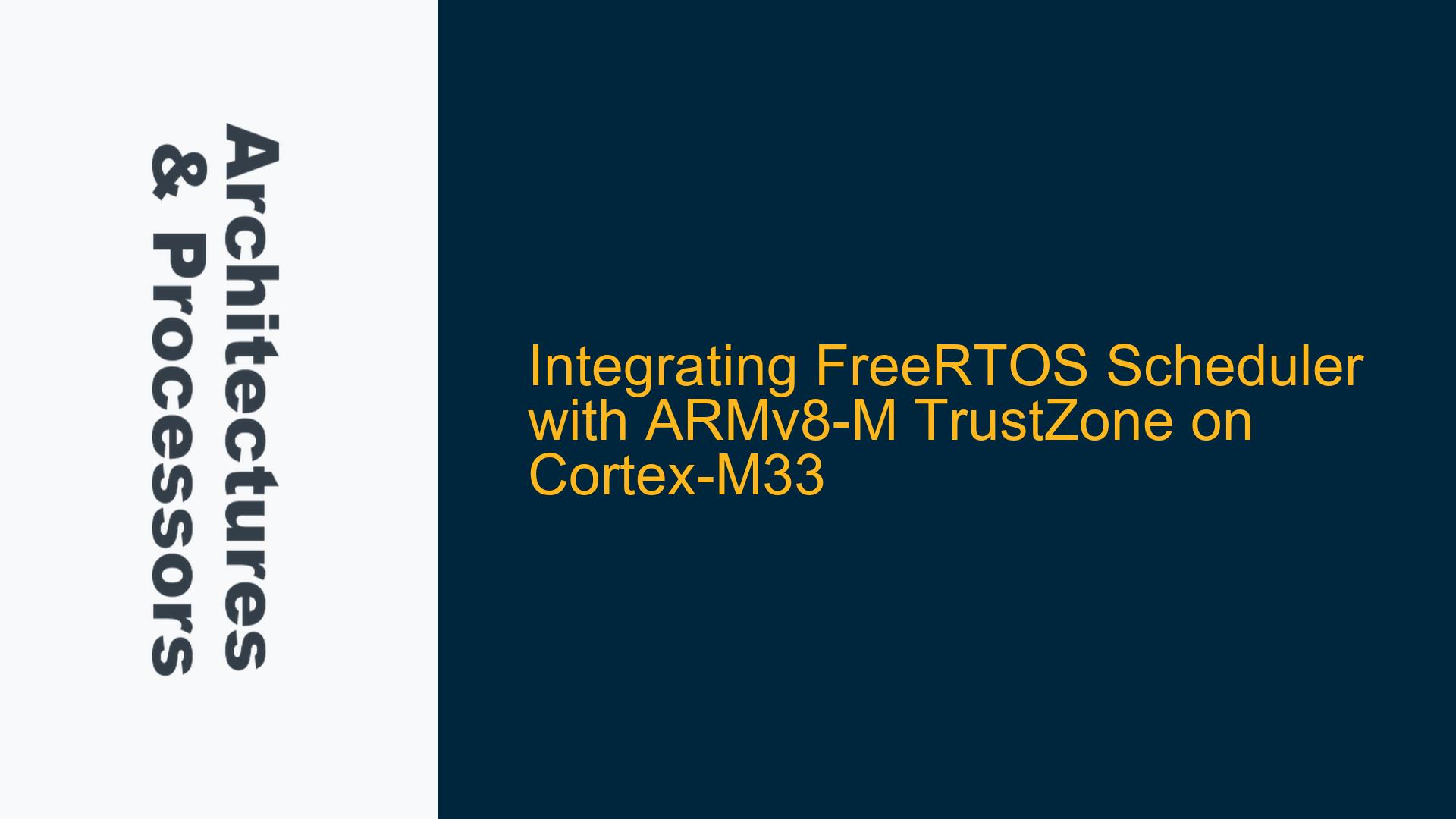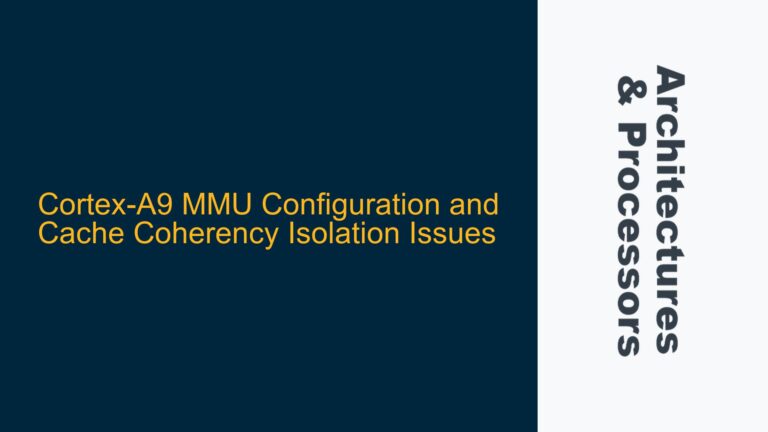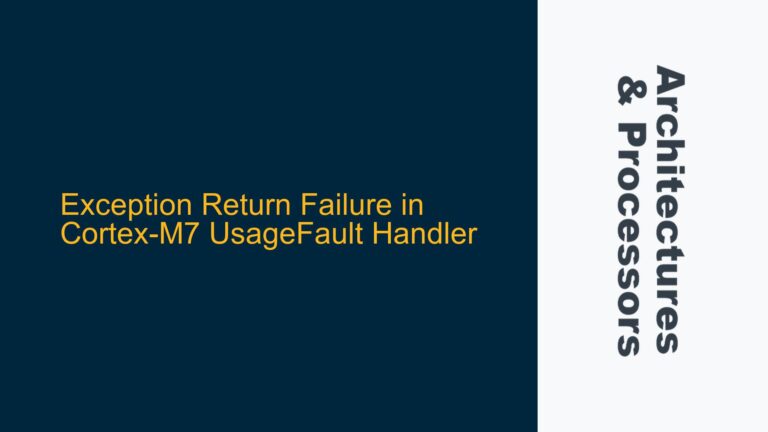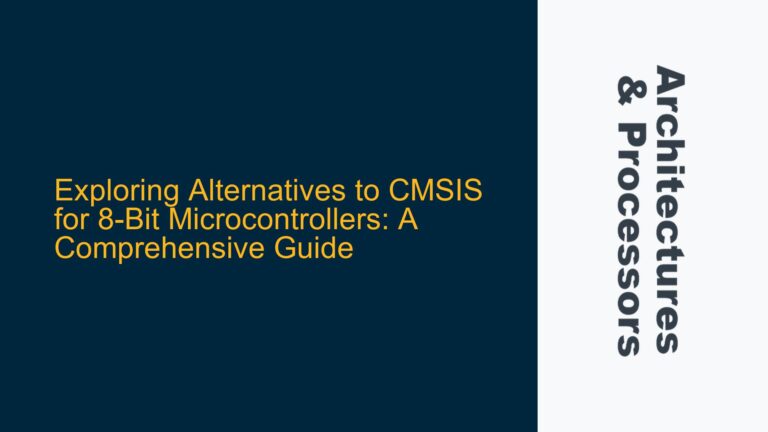FreeRTOS Task Scheduling Across Secure and Non-Secure Worlds in ARMv8-M TrustZone
The integration of FreeRTOS with ARMv8-M TrustZone on Cortex-M33 processors presents a unique challenge due to the separation of secure and non-secure worlds. The Cortex-M33 processor, part of the ARMv8-M architecture, introduces TrustZone technology, which provides hardware-enforced isolation between secure and non-secure states. This isolation is critical for security-sensitive applications but complicates the operation of real-time operating systems (RTOS) like FreeRTOS, which must manage tasks across both worlds.
In a typical FreeRTOS implementation, the scheduler manages task execution, context switching, and resource allocation. However, when TrustZone is enabled, tasks running in the secure world cannot directly access non-secure resources, and vice versa. This separation necessitates careful design to ensure that the FreeRTOS scheduler can effectively manage tasks in both worlds without violating security boundaries.
The core issue revolves around establishing communication between the secure and non-secure worlds while maintaining the integrity of the TrustZone isolation. This communication is essential for task synchronization, resource sharing, and inter-world function calls. The Secure Monitor Call (SMC) instruction is typically used for such communication, but its integration with FreeRTOS requires a deep understanding of both the RTOS and the ARMv8-M architecture.
Secure Monitor Call (SMC) Integration and Task Synchronization Challenges
One of the primary challenges in integrating FreeRTOS with ARMv8-M TrustZone is the proper use of the Secure Monitor Call (SMC) instruction. The SMC instruction allows software in the non-secure world to request services from the secure world, and vice versa. However, the timing and context of these calls must be carefully managed to avoid race conditions, deadlocks, or security violations.
In a multi-task environment managed by FreeRTOS, tasks in the non-secure world may need to request services from the secure world, such as accessing secure peripherals or invoking secure functions. These requests must be synchronized with the FreeRTOS scheduler to ensure that the secure world can handle them without disrupting the real-time behavior of the system.
Another challenge is the management of task contexts across the secure and non-secure worlds. FreeRTOS typically maintains a task control block (TCB) for each task, which includes the task’s stack pointer, program counter, and other state information. When a task in the non-secure world makes an SMC call, the secure world must save and restore the task’s context to ensure that the task can resume execution correctly after the call.
Furthermore, the FreeRTOS scheduler must be aware of the security state of each task to prevent unauthorized access to secure resources. This requires modifications to the scheduler to handle task states in both the secure and non-secure worlds, as well as mechanisms to enforce security policies during task switching.
Implementing Secure Context Switching and Scheduler Modifications
To address the challenges of integrating FreeRTOS with ARMv8-M TrustZone, several modifications and best practices must be implemented. These include secure context switching, scheduler modifications, and the use of memory protection units (MPUs) to enforce security policies.
Secure Context Switching
Secure context switching involves saving and restoring the state of tasks when transitioning between the secure and non-secure worlds. This is particularly important when a task in the non-secure world makes an SMC call to the secure world. The secure world must save the non-secure task’s context, execute the requested service, and then restore the task’s context before returning control to the non-secure world.
To implement secure context switching, the FreeRTOS scheduler must be extended to include secure context save and restore functions. These functions should be invoked whenever an SMC call is made, ensuring that the task’s state is preserved across the world transition. Additionally, the secure context save and restore functions must be designed to minimize overhead, as excessive context switching can degrade the real-time performance of the system.
Scheduler Modifications
The FreeRTOS scheduler must be modified to handle tasks in both the secure and non-secure worlds. This includes maintaining separate task lists for secure and non-secure tasks, as well as implementing security checks during task scheduling. For example, the scheduler must ensure that a non-secure task cannot be scheduled to run in the secure world, and vice versa.
One approach to implementing these modifications is to introduce a secure task flag in the task control block (TCB). This flag indicates whether a task is running in the secure or non-secure world, allowing the scheduler to enforce security policies during task switching. Additionally, the scheduler must be modified to handle the transition between secure and non-secure states, ensuring that tasks are scheduled correctly based on their security context.
Memory Protection Unit (MPU) Configuration
The ARMv8-M architecture includes a Memory Protection Unit (MPU) that can be used to enforce memory access policies in both the secure and non-secure worlds. The MPU can be configured to restrict access to secure memory regions from non-secure tasks, preventing unauthorized access to sensitive data.
To integrate the MPU with FreeRTOS, the MPU configuration must be updated whenever a task switch occurs. This ensures that each task has the appropriate memory access permissions based on its security context. For example, when a non-secure task is scheduled to run, the MPU should be configured to restrict access to secure memory regions. Conversely, when a secure task is scheduled, the MPU should allow access to secure memory regions.
The MPU configuration must also be updated during SMC calls to ensure that the secure world can access the necessary resources while maintaining isolation from the non-secure world. This requires careful coordination between the FreeRTOS scheduler and the MPU configuration logic.
Example Implementation
To illustrate the implementation of secure context switching and scheduler modifications, consider the following example. Assume that a non-secure task makes an SMC call to request a service from the secure world. The following steps outline the process:
-
Non-Secure Task Makes SMC Call: The non-secure task invokes the SMC instruction, passing the necessary parameters to the secure world.
-
Secure Context Save: The secure world saves the non-secure task’s context, including the task’s stack pointer, program counter, and other state information.
-
Secure Service Execution: The secure world executes the requested service, accessing secure resources as needed.
-
Secure Context Restore: After completing the service, the secure world restores the non-secure task’s context, ensuring that the task can resume execution correctly.
-
Task Scheduling: The FreeRTOS scheduler resumes scheduling tasks in the non-secure world, ensuring that the non-secure task that made the SMC call is scheduled appropriately.
Best Practices
To ensure a successful integration of FreeRTOS with ARMv8-M TrustZone, the following best practices should be followed:
-
Minimize Context Switching Overhead: Secure context switching can introduce significant overhead, especially in systems with frequent SMC calls. To minimize this overhead, optimize the context save and restore functions, and consider using hardware acceleration where available.
-
Enforce Security Policies: Ensure that the FreeRTOS scheduler enforces security policies during task switching, preventing unauthorized access to secure resources. This includes maintaining separate task lists for secure and non-secure tasks and using the MPU to enforce memory access policies.
-
Test Thoroughly: Thoroughly test the integrated system to ensure that it meets both real-time and security requirements. This includes testing for race conditions, deadlocks, and security violations, as well as verifying that the system meets its real-time performance goals.
-
Document the Implementation: Document the modifications made to FreeRTOS and the ARMv8-M TrustZone integration, including the secure context switching logic, scheduler modifications, and MPU configuration. This documentation will be invaluable for future maintenance and debugging.
Conclusion
Integrating FreeRTOS with ARMv8-M TrustZone on Cortex-M33 processors requires careful consideration of the security and real-time requirements of the system. By implementing secure context switching, modifying the FreeRTOS scheduler, and configuring the MPU, it is possible to create a robust and secure real-time system that leverages the benefits of TrustZone technology. Following best practices and thoroughly testing the system will ensure that it meets both security and performance goals, providing a solid foundation for secure embedded applications.






